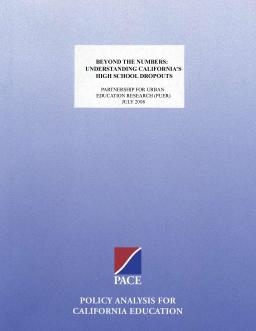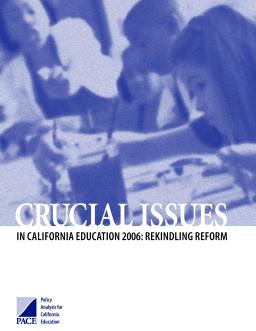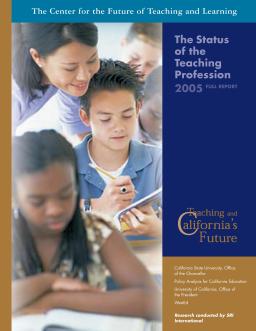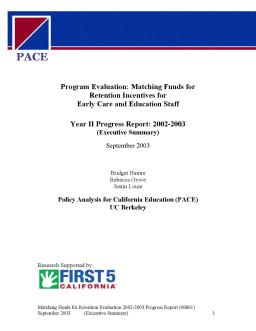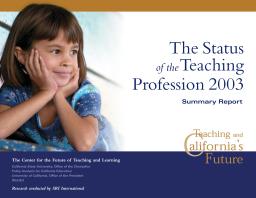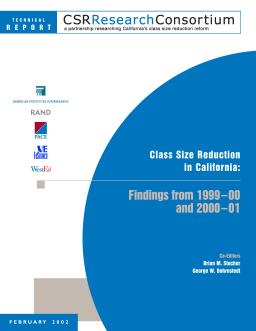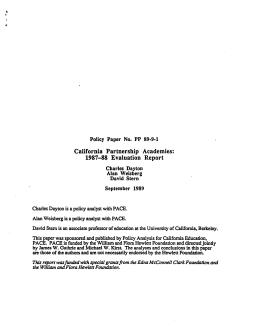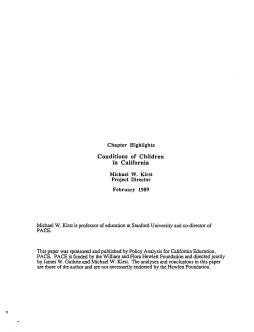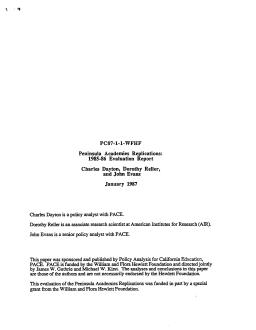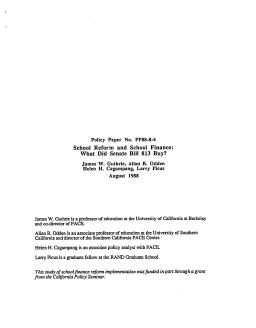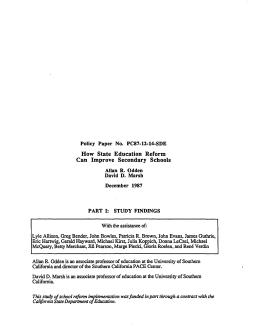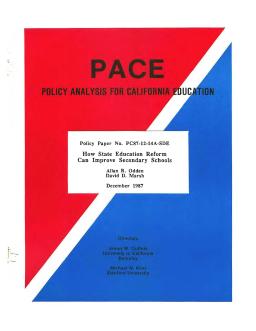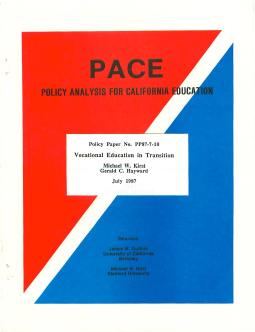Published
Summary
PACE is bringing back its publication, Conditions of Education in California, to keep the focus on the long-term education reforms required by California. Six policy scholars have contributed to this edition, providing baseline data on school performance and recommendations for policy changes to support long-term improvement. PACE plans to continue regular publication of this report to track progress towards a more effective educational system in California.
Understanding California's High School Dropouts
Published
Summary
The Partnership for Urban Education Research (PUER) comprises six of California's largest urban school districts working together to increase data availability, enhance internal research capacity, and promote collaboration and information sharing across district lines to benefit students. In a new report, PUER districts identified opportunities to improve the current dropout reporting system and reviewed district efforts to reduce dropout rates. PUER is working with PACE to review and publish their research.
Rekindling Reform
Published
Summary
This report discusses key education policy challenges in California, including funding, teacher quality, achievement gaps, and school accountability. The report highlights the need for equitable funding and effective teacher training and retention programs to address these issues. It also emphasizes the importance of holding schools accountable for student achievement and providing targeted support to struggling schools. The report concludes by calling for sustained attention to these critical education issues to ensure that all California students have access to a high-quality education.
Full Report
Published
Summary
The Teaching and California's Future initiative provides policymakers with data on the teacher workforce and labor market. The initiative's annual report details teacher development policies and their impact on teacher quality and distribution. The goal is to help policymakers make informed decisions about strengthening the state's teacher workforce.
Published
Summary
The quality of teaching and the need to expand California's ranks of excellent teachers demand urgent public discussion. We must attract the best and brightest to teaching, prepare them effectively, and support and retain them. Solutions require bipartisan leadership, not spin. This report presents the latest research and projections, highlighting that while some numbers are improving, we're likely to face severe shortages again soon and the pipeline for recruiting, preparing, and training teachers has substantial problems.
California’s Teaching Force, 2004—Key Issues and Trends
Published
Summary
California's aging teacher workforce will lead to a significant demand for teachers, with shortages particularly in special education and secondary education. The number of underprepared teachers in low-performing schools serving minority, poor, and ELL students is disproportionate. Budget cuts have reduced funding for recruitment and professional development programs, and California's induction system needs refinement. Curriculum-based professional development programs have mainly targeted elementary school teachers, neglecting the training needs of secondary teachers.
Year Two Progress Report, 2002–03—Executive Summary
Published
Summary
This report highlights findings from a 2002-03 progress report on First 5 California's childcare retention incentive programs, aimed at improving retention and increasing training among early care and education staff. Data were collected from ten counties through a phone survey of participants and site visits. Initial findings related to program design and implementation, program participation, training and professional development, and retention are summarized.
Summary Report
Published
Summary
This report argues that the state of California needs to prioritize better education for all children with a sustained long-term investment of resources and leadership. Despite political upheaval and fiscal problems, there is a consensus for better education. The authors suggest that the issue requires a response as intense and sustained as the state's response to natural disasters, and calls for a system of teacher development to ensure all teachers have the necessary knowledge and skills to meet academic standards.
Published
Summary
This report discusses the implementation and impact of class size reduction in California's K-3 classrooms. The initiative was prompted by concerns over falling standardized test scores in the mid-1990s. The report includes findings from a consortium of evaluators, including PACE, and provides policy recommendations and lessons learned.
Year 1—Qualitative Implementation Study
Published
Summary
This report provides guidance on implementing childcare retention initiatives based on Alameda County’s Child Development Corps program. PACE conducted focus groups with stakeholders to gather feedback on the planning and implementation process. The program saw increased commitment from providers to their profession and seeking training opportunities, but challenges remain with fitting permit requirements to family providers and relevance of courses.
Findings from 1999–2000 and 2000–01
Published
Summary
This report evaluates California's Class Size Reduction (CSR) program up to the 2000-01 school year, updating previous findings on teacher qualifications, curriculum, student achievement, and special populations. The report also discusses how districts and schools have allocated resources in support of CSR.
New Education Policies
Published
Summary
Senior slump is a phenomenon unique to American high schools, where students view senior year as a time for nonacademic pursuits. This report suggests curtailing senior slump to add valuable months to students' education at a critical point in their intellectual development. Policy directives are presented to help American high schools reclaim the senior year.
1987–88 Evaluation Report
Published
Summary
This report presents findings from the third annual evaluation of Partnership Academy Programs in CA, a high school-based, state-funded program with a school-within-a-school administrative structure that enrolls at-risk students with academic potential. The program provides students with basic job skills in a promising labor-market field and support from local businesses, including curriculum development, guest speakers, field trips, mentors, and work experience positions. The evaluation addresses the quality of program implementation and the degree to which programs follow the academy model.
A Hypothetical Account and Research Review
Published
Summary
This paper discusses childcare quality and its impact on child development. It highlights the need to consider various factors that contribute to quality and how they affect children's experiences. Presented is a hypothetical day in two different childcare situations to demonstrate the varying experiences children have. The characters and incidents are fictional but based on the author's real observations and experiences in early childhood programs in CA. The author emphasizes the need to promote quality early childhood programs informed by research in child development and early education.
Published
Summary
California's growing child population will require significant increases in public spending, particularly in education due to immigration, working parents, poverty, and family disorganization. Counties and school districts bear the brunt of providing children's services, but cities have greater fiscal flexibility and revenue-raising potential. This paper provides information on county children's services and trends in county budgets to support further research on county financing for children's services.
Chapter Highlights
Published
Summary
This report provides social indicators to evaluate the quality of life for children in California, covering physical and mental health, safety, sexual behavior, academic achievement, and the settings and systems that serve children. Despite most children being healthier and better schooled than in the past, recent polls indicate concern about child-rearing and the likelihood of an expanding educational underclass. The report aims to offer a portrait of the quality of California's children, address gaps in available data, and provide limited policy recommendations.
Graduate Follow-up Survey
Published
Summary
A survey was conducted on the first class of participants in the "Jobs for the Disadvantaged" program and a comparison group six months after graduation. Although the sample size was small, a significantly higher percentage of program participants graduated on time than the comparison group. About half of both groups were in postgraduate schooling, but more program graduates were working. Among those in school, few differences were found. For those working, twice as many program graduates secured work through school, but comparison-group graduates had somewhat higher wages.
1986–87 Evaluation Report
Published
Summary
In the fall of 1985, ten academy programs were established by the State of California as replications of the Peninsula Academies. PACE evaluated these 10 academies in 1985–86. This report presents findings from a second evaluation covering the academies' 1986–87 school year.
Program Successes and Evaluations Under 'Jobs for the Disadvantaged'
Published
Summary
This report discusses the challenges of implementing broad state-level initiatives to reform schools in California, following the passage of S.B. 813 in 1983. While earlier studies showed the formal implementation of these reforms, their impact on local schools and substantive changes remained unclear. The article uses data to answer the question of whether these state-level initiatives can improve local schools, concluding that successful implementation depends on several factors. The evaluations also revealed lessons about conducting evaluations and obtaining necessary data from schools.
Published
Summary
The fourth edition of Conditions of Education in California has expanded its content to include a special features section on education reform processes, along with the previously included sections. The publication is based on compiled information from other sources and original data collection and analysis. The format has been altered to improve readability for a wide range of audiences.
Study Findings
Published
Summary
In 1983, California's Senate Bill 813 aimed to improve the education system by proposing a large number of reforms. However, it lacked a cohesive strategy and proven philosophy. The bill's impact on school districts and schools was unknown, and this study aimed to assess whether selected schools could implement the reform components and whether they contributed to school improvement. The goal was to understand how schools reacted to state mandates and inducements for improvement.
A Preschool Through High School Concern
Published
Summary
This report explores why thousands of students continue to drop out despite the belief that education is necessary for success. By examining dropout characteristics and behavior from preschool through high school, it presents the experience of selected dropout prevention programs. Focusing on the specific act of dropping out may neglect earlier clues, so understanding students' experiences as they progress through grades is crucial for effective prevention strategies.
Background and Technical Appendices
Published
Summary
California's education system faced a decline in the early 1980s, prompting reforms such as a common core curriculum, higher graduation requirements, and tougher academic standards. A Nation at Risk report further pushed for nationwide school changes. California's swift response led to the enactment of Senate Bill 813, a comprehensive education reform program with over 80 policy and program reforms. Several studies showed positive results, but the study in this report aims to determine how state-level education reforms improved local schools.
Published
Summary
This report discusses the decline in vocational education enrollment in California and its potential impact on noncollege-bound students' high school completion rates. Questions remain about the objectives of vocational education and whether it should prioritize skill training for entry-level jobs or emphasize academic skills for a working life of continual learning. PACE recommends a re-examination of curricular changes with a special focus on transitions occurring in vocational education due to enrollment declines and changes in the US job structure.
A Study of Year-Round Education in California
Published
Summary
As California schools face increasing enrollment and competition for resources, many have turned to year-round education as a solution. However, little is known about the educational impact of year-round programs. This report analyzes and synthesizes information on all schools with year-round programs in California, presenting issues to inform decision makers at both local and statewide levels. It is the first attempt to provide a statewide perspective on year-round education.

